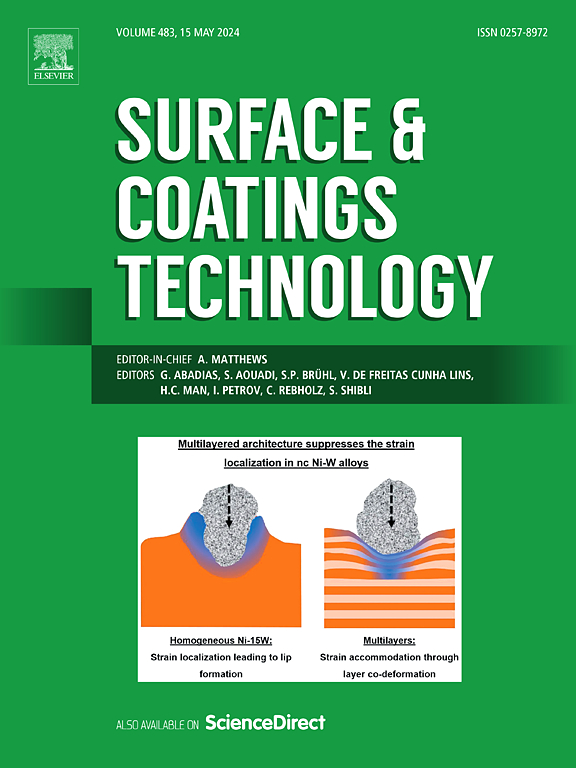IF 5.3
2区 材料科学
Q1 MATERIALS SCIENCE, COATINGS & FILMS
引用次数: 0
摘要
倒置火球(IFB)是等离子物理学的一个突破性进展,它将等离子体密度和表面改性能力的控制提升到了一个新的水平。尽管倒置火球具有非凡的潜力,但如何将其与现有的工业流程相结合仍是一项重大挑战。在这里,我们首次成功地将 IFB 配置集成到磁控溅射系统中,这标志着等离子体辅助镀膜技术取得了重大突破。我们以高速钢上的钛沉积为模型系统,研究了等离子体参数和由此产生的薄膜特性。多极共振探针测量显示等离子体密度达到 1 × 1016 m-3,而光学发射光谱则提供了对等离子体组成的深入了解。与传统的磁控溅射相比,IFB 辅助磁控溅射工艺产生的薄膜具有显著增强的机械性能,尤其是硬度。这种使用磁控溅射源和中频炉的新方法可以应用于固体前驱体和金属基等离子体。我们的成果为等离子体辅助镀膜工艺建立了一个新范例,为工业应用提供了更高的效率和更强的技术可能性。这种创新性的 IFB 和磁控溅射技术的结合为先进的材料加工和表面工程开辟了新的途径。本文章由计算机程序翻译,如有差异,请以英文原文为准。

Pioneering work for the implementation of the inverted fireball technology for more effective PVD magnetron sputtering
Inverted fireballs (IFBs) represent a groundbreaking advance in plasma physics, offering a new level of control over plasma density and surface modification capabilities. Despite their remarkable potential, the integration of IFBs with established industrial processes remains a significant challenge. Here, we demonstrate the first successful incorporation of an IFB configuration into a magnetron sputtering system, marking a crucial breakthrough in plasma-assisted coating technology.
Using titanium deposition onto high-speed steel as a model system, we investigated plasma parameters and resulting film properties. Multipole resonance probe measurements revealed plasma densities reaching 1 × 1016 m−3, while optical emission spectroscopy provided insights into the plasma composition. The IFB-assisted magnetron sputtering process yielded films with significantly enhanced mechanical properties, particularly increased hardness, compared to conventional magnetron sputtering.
This advance overcomes the previous limitations of IFB technology, which was restricted to DC or AC discharges and gaseous precursors. This new approach, using a magnetron sputtering source and an IFB, enables its application with solid precursors and metal-based plasmas. Our results establish a new paradigm for plasma-assisted coating processes, offering improved efficiency and enhanced technological possibilities for industrial applications. This innovative combination of IFB and magnetron sputtering technologies opens new avenues for advanced materials processing and surface engineering.
求助全文
通过发布文献求助,成功后即可免费获取论文全文。
去求助
来源期刊

Surface & Coatings Technology
工程技术-材料科学:膜
CiteScore
10.00
自引率
11.10%
发文量
921
审稿时长
19 days
期刊介绍:
Surface and Coatings Technology is an international archival journal publishing scientific papers on significant developments in surface and interface engineering to modify and improve the surface properties of materials for protection in demanding contact conditions or aggressive environments, or for enhanced functional performance. Contributions range from original scientific articles concerned with fundamental and applied aspects of research or direct applications of metallic, inorganic, organic and composite coatings, to invited reviews of current technology in specific areas. Papers submitted to this journal are expected to be in line with the following aspects in processes, and properties/performance:
A. Processes: Physical and chemical vapour deposition techniques, thermal and plasma spraying, surface modification by directed energy techniques such as ion, electron and laser beams, thermo-chemical treatment, wet chemical and electrochemical processes such as plating, sol-gel coating, anodization, plasma electrolytic oxidation, etc., but excluding painting.
B. Properties/performance: friction performance, wear resistance (e.g., abrasion, erosion, fretting, etc), corrosion and oxidation resistance, thermal protection, diffusion resistance, hydrophilicity/hydrophobicity, and properties relevant to smart materials behaviour and enhanced multifunctional performance for environmental, energy and medical applications, but excluding device aspects.
 求助内容:
求助内容: 应助结果提醒方式:
应助结果提醒方式:


